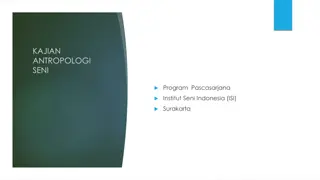Understanding Triad Tests in Cognitive Anthropology
Triad tests are a valuable tool in cognitive anthropology, originally introduced by George Kelly in 1955. They involve presenting individuals with sets of three items and eliciting responses based on similarity or dissimilarity. This method allows researchers to explore differences in cognition across individuals and cultures, offering insights into how people perceive and categorize objects. Triad tests have been widely used in various fields, such as personal construct psychology and anthropology, to study cognitive processes and cultural perceptions.
Download Presentation

Please find below an Image/Link to download the presentation.
The content on the website is provided AS IS for your information and personal use only. It may not be sold, licensed, or shared on other websites without obtaining consent from the author. Download presentation by click this link. If you encounter any issues during the download, it is possible that the publisher has removed the file from their server.
E N D
Presentation Transcript
Triad tests Collecting and making similarity data
Background The triad test: from personal construct psychology and the repertory grid developed by George Kelly in 1955. Adopted by cognitive psychologists and anthropologists to measure similarities among pairs of objects. Informants respond to the same set of cues and data can be compared across individuals. Kelly, G. A. 1955. The psychology of personal constructs.New York: Norton.
Triad tests In a triad test, you show people three things and tell them to: Choose the one that doesn t fit or Choose the two that seem to go together best, or Choose the two that are the same. The things can be photographs, dried plants, or 3 x 5 cards with names of people on them.
DOLPHIN MOOSE WHALE SHARK DOLPHIN MOOSE Dolphin is the odd item in triad 1 if people are thinking about size. It s moose if people are thinking land vs. sea.
People often ask What do you mean by things being the same or fitting together ? Tell them that you are interested in what they think that means. By doing this for all triples from a list of things or concepts, you can explore differences in cognition among individuals, and among cultures and subcultures.
First use in anthropology Romney and D Andrade (1964) presented people with triads of American kinship terms and asked them to choose the term that was most dissimilar in each triad. For the triad father, son, nephew, 67% selected nephew as the most different of the three items; 22% chose father. Romney, A. K., and R. G. D Andrade, eds. 1964. Cognitive aspects of English kin terms. In Transcultural studies in cognition. American Anthropologist 66 (3, part 2, entire issue): 146 70
Ask people to explain their choices For the triad grandson, brother, father, one informant said that a grandson is most different because he is moved down further. There s a lot of cultural wisdom in that statement.
Bilingualism and St. Lucian disease terms Does cognition of disease terms vary with bilingual proficiency in St. Lucia? 52 bilingual English-Patois speakers and 10 monolingual Patois speakers. n(n-1)(n-2) 6 Here is the formula for calculating the number of triples in a set of items: With 9 disease terms, there are 84 possible triads. Lieberman, D., and W. W. Dressler. 1977. Bilingualism and cognition of St. Lucian disease terms. Medical Anthropology 1:81 110.
For the bilingual informants: Two triad tests, a week apart, one in Patois and one in English. They also measured how bilingual their informants were. For the monolingual informants The 10 monolingual Patois informants were simply given the triad test.
There are n(n-1)/2 pairs in a set of items For 9 items, there are 9(8)/2=36 pairs of items Count the number of times that each of the 36 possible pairs of terms was chosen as most alike in the 84 triads. Each term in a triad test appears n-1 times, and each pair appears n-2 times, so they divided the total by seven.
Triads as similarities This produced a similarity coefficient, varying between 0.0 and 1.0, in increments of 0.14 (1/7) for each possible pair of disease terms. The larger the coefficient for a pair of terms, the closer in meaning are the two terms.
They analyzed these data for English-dominant, Patois-dominant, and monolingual Patois speakers. When Patois-dominant and English-dominant informants took the triad test in English, their cognitive models of similarities among diseases was similar.
When Patois-dominant speakers took the Patois- language triad test, however, their cognitive model was similar to that of monolingual Patois informants.
The take-away: Patois-dominant bilinguals hold on to two psychological models about diseases and switch back and forth, depending on the language they are speaking. English-dominant bilinguals employ the same cognitive model of disease terms, whichever language they speak.
BIBDs Balanced incomplete block designs Typically, the terms for a triad test are generated by a free list. Free lists of illnesses, ways to prevent pregnancy, advantages of breast-feeding, places to go on vacation, and so on easily produce 60 items or more. Even an abbreviated list for a pile sort may be 30 items.
With just 9 terms, there are 84 stimuli in a triad test. For 15 items, the number of decisions an informant has to make jumps to 455. At 20 items, it s a mind-numbing 1,140.
Burton and Nerloves solution Balanced incomplete block designs take advantage of the fact that there is a lot of redundancy in a triad test. For 4 items, there are 6 pairs. If you ask Which of these two foods is more nutritious? the informant sees each pair just once. Burton, M. L., and S. B. Nerlove. 1976. Balanced design for triad tests. Social Science Research 5:247 67.
Recall that in a triad test informants see each triad n(n 1)(n 2)/6 times and each pair n 2=2 times. With 84 triads for 9 items, each pair of items appears 7 times.
Redundancy and lambda designs This redundancy lets us reduce the number of triads in a triads test. If each pair appears once (a lambda 1 design), then only 12 triads are needed. If each pair appears twice (a lambda 2 design), then 24 triads are needed.
For a lambda 1 design, each pair of items in the similarity matrix gets a score of either 1 or 0. For a lambda 2 design, each pair of items in the similarity matrix is 0, .5. or 1.
For 10 items, a lambda 2 design requires 30 triads; for 13 items, 52 triads; for 15 items, 70 triads; for 19 items, 114 triads; and for 25 items, 200 triads. Here are the solutions from Burton and Nerlove for 9 and 10 items.
Balanced Incomplete Block Designs for Triad Tests Involving 9 and 10 Items For 9 items, 24 triads are needed, as follows: Items For 10 items, 30 triads are needed, as follows: Items 1, 5, 9 2, 3, 8 4, 6, 7 1, 2, 3 4, 5, 6 7, 8, 9 1, 2, 3 2, 5, 8 4, 1, 6 5, 8, 7 7, 9, 1 9, 3, 10 6, 8, 9 7, 10, 3 8, 1, 10 3, 7, 4 2, 6, 9 1, 3, 4 5, 7, 8 1, 4, 7 2, 5, 9 3, 6, 8 9, 5, 2 10, 6, 7 1, 3, 5 6, 4, 9 3, 7, 9 2, 4, 5 1, 6, 9 2, 4, 8 2, 7, 6 3, 8, 9 8, 10, 2 1, 6, 8 4, 8, 9 3, 5, 7 1, 5, 8 4, 2, 10 5, 6, 3 10, 6, 5 1, 2, 4 6, 1, 8 3, 5, 6 2, 6, 8 2, 3, 6 7, 9, 2 1, 2, 7 3, 4, 9 2, 4, 8 8, 4, 7 4, 9, 5 5, 7, 1 9, 10, 1 10, 5, 4
BIBDs reduce accuracy In a L1 design, each pair of items occurs in the context of just one other item. For dog, parakeet, whale, many people pick whale, even though dog and parakeet are not that similar. Thus the similarity between two items is defined by a single, third item.
Steps in making a triads test 1. Identify domain. 2. Do key informant interviewing /free listing. 3. Select short list from the total list. 4. Choose a BIBD or use a complete triad test. 5. Make the triad tests using Anthropac (randomize to eliminate order effects). 6. Collect triad data. 7. Score the data and unrandomize if necessary Instructions for data entry in the Anthropac manual
Procedure in Anthropac Tell Anthropac the list of items you have. Select a design (e.g. L1, L2). Tell it the number of informants you want to interview.
Anthropac prints out a randomized triad test, one for each informant. Randomizing the order in which the triads appear to informants eliminates order-effects. Anthropac unrandomizes the data on import.
Plusses and minuses of triad tests Triad tests are easy to create with Anthropac, easy to administer, and easy to score. Use with relatively few items in a domain. In literate societies, most people respond to 200 triads in <.5hr, but it s boring. Literate informants easily handle L2 tests with 15 items and 70 triads. People prefer even like to do pile sorts, but pile sorts have their own problems.























